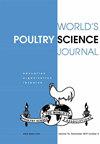三重缓冲蛋白胨肉鸡饲料中沙门氏菌检测的评价
IF 3.5
3区 农林科学
Q1 AGRICULTURE, DAIRY & ANIMAL SCIENCE
引用次数: 0
摘要
由于细菌对饲料碳水化合物的利用,含有饲料/配料的预富集培养基的pH值在培养过程中会变为酸性。这种pH值的降低会导致细胞损伤或死亡,对沙门氏菌的检测产生负面影响。我们的目的是评价一种新的三重缓冲蛋白胨(TBP)对抗缓冲蛋白胨水(BPW)和乳糖肉汤(LB)从饲料中回收沙门氏菌的效果。将耐草酸沙门氏菌(Enteritidis, Heidelberg, Kentucky或Typhimurium)的液体培养物单独添加到预富集培养基中,添加到含饲料的预富集培养基中,或添加到人工接种的饲料中,保存1 d或7 d,以评估培养基对沙门氏菌恢复的影响。每个处理进行3个重复。37℃孵育24小时后,测定培养基的pH值,然后将其镀在添加了200 ppm萘啶酸(BGSNA)的亮绿色磺胺琼脂板上。培养皿孵育并评估典型沙门氏菌菌落的存在。这个实验被重复了。TBP的缓冲能力明显优于BPW和LB。此外,TBP的沙门氏菌回收率为100%,而BPW的回收率为97.9%,LB的回收率为61.5%。TBP有望在预富集期间保持中性pH值,这可能允许更准确地检测饲料中的沙门氏菌。本文章由计算机程序翻译,如有差异,请以英文原文为准。
Evaluation of a Triple Buffered Peptone Broth for Detection of Salmonella in Broiler Feed
The pH of pre-enrichment media containing feed/ingredients can become acidic during incubation due to bacterial utilization of feed carbohydrates. This decrease in pH can result in cell injury or death, negatively impacting the detection of Salmonella. Our objective was to evaluate a new triple buffered peptone (TBP) against buffered peptone water (BPW) and lactose broth (LB) for the recovery of Salmonella from feed. Liquid cultures of nalidixic acid resistant strains of Salmonella (Enteritidis, Heidelberg, Kentucky or Typhimurium) were added to the pre-enrichment media alone, to pre-enrichment media containing feed or to artificially inoculated feed stored 1 or 7 d to evaluate the effect of the medium on the recovery of Salmonella. Three replicates per treatment were conducted. After incubation at 37 °C for 24 h, the pH of the medium was measured prior to plating onto brilliant green sulfa agar plates supplemented with 200 ppm nalidixic acid (BGSNA). Plates were incubated and evaluated for presence of typical Salmonella colonies. The experiment was replicated. TBP was observed to exhibit significantly better buffering capacity than BPW or LB. Additionally, TBP was able to recover Salmonella 100% of the time compared to BPW (97.9%) and LB (61.5%). TBP shows promise to maintain neutral pH during pre-enrichment which may allow for a more accurate detection of Salmonella in feed.
求助全文
通过发布文献求助,成功后即可免费获取论文全文。
去求助
来源期刊

World's Poultry Science Journal
农林科学-奶制品与动物科学
CiteScore
6.10
自引率
7.40%
发文量
55
审稿时长
12-24 weeks
期刊介绍:
World''s Poultry Science Journal is the official publication of the World’s Poultry Science Association. The journal provides authoritative reviews in poultry science and an international forum for the exchange and dissemination of information including research, education and industry organisation. Each issue includes poultry industry-related news, regional reports on global developments in poultry, reports from specialist scientific working groups, book reviews, association news and a calendar of forthcoming events. Coverage includes breeding, nutrition, welfare, husbandry, production systems, processing, product development, physiology, egg and meat quality, industry structure, economics and education. The journal is of interest to academics, researchers, students, extension workers and commercial poultry producers.
 求助内容:
求助内容: 应助结果提醒方式:
应助结果提醒方式:


